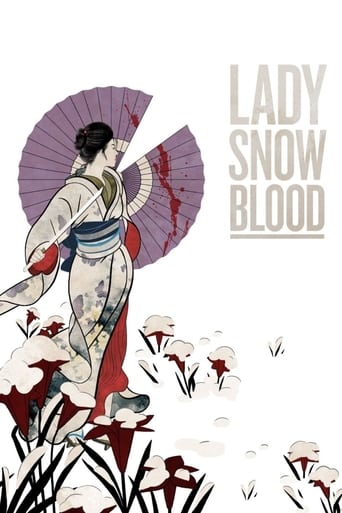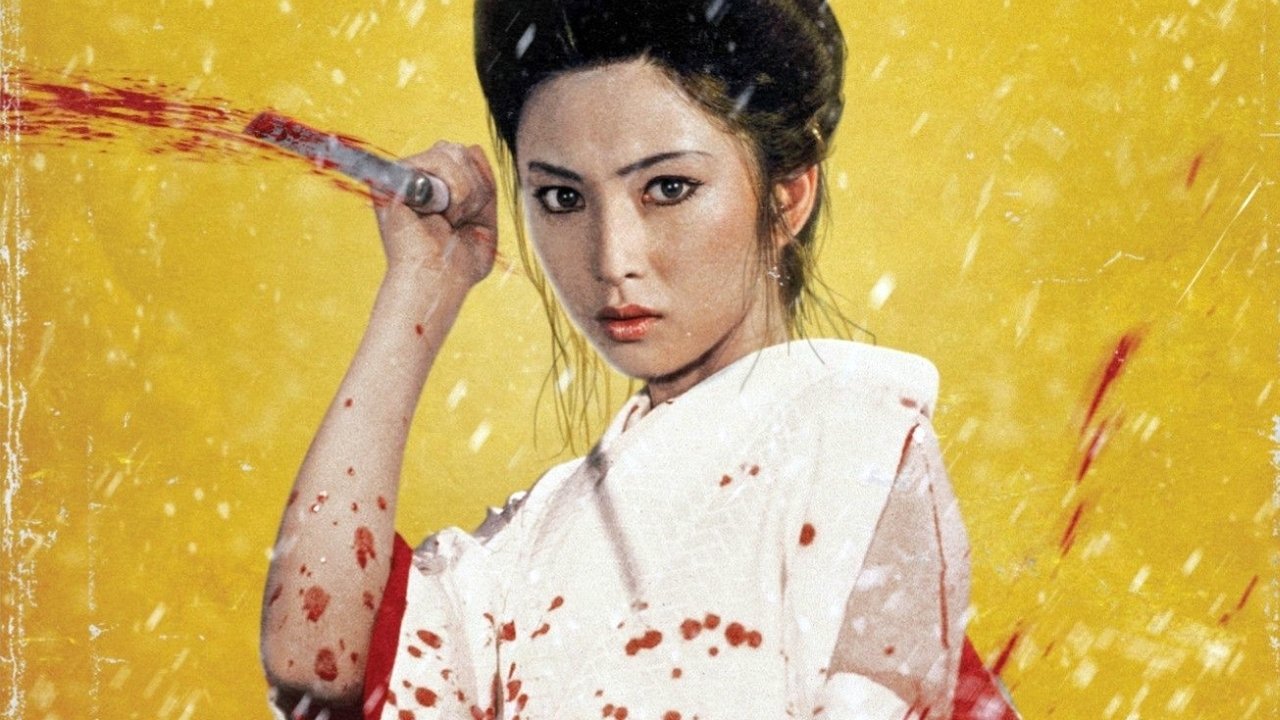classicsoncall
Even without knowing it or reading other reviews of the picture on this board, I had an instinctive feeling that this film would have been an inspiration for Tarantino's "Kill Bill" films. Many of the elements in this picture surface again in his movies, and others have done a fine job of detailing those specifics, so I won't have to go into them here.What I liked about this story had to do with not following the typical revenge route that most Ninja assassin flicks take. Yuki Kashima (Meiko Kaji) wasn't trained in the physical martial arts per se, her brutal disciplinarian Dokai (Ko Nishimura) instructed her in skilled swordsmanship. There was also the uniquely creative idea of using a newspaper writer to tell the 'fictional' story of Lady Snowblood in such a way as to parallel Yuki's life experience to draw out her victims from hiding.What detracts from these tales somewhat, at least for me, is the brilliant clarity of all that bright red blood spurting around whenever a swordsman/swordswoman contacts a vital organ. Granted, it's done for effect, but it just doesn't come across realistically. Nor does the ease with which one can cut a victim's body in half as if slicing through a brick of butter. Could it be that easy? I hardly think so.One element introduced in the story sounded intriguing enough that I had to look it up. That had to do with what the picture described as the 'Blood Tax Riots of 1873'. It turns out that this wasn't so much a revolt against a pecuniary tax (although two hundred seventy yen in the story would relieve one's duty), but one against the Meiji government's attempt at a conscription service. There were other policies of the government that met with hostility as well, such as land and education reform that did not meet with the approval of those whose lives were being affected.With that backdrop, introducing the Blood Tax Riots into the story was generally a moot point, since Yuki was a woman who would not have been affected by conscription. Thinking about that, I had to wonder why the idea was introduced in the first place, other than it sounding cool.Anyway, the story does manage to take some interesting twists and turns relative to the identities of the three victims Yuki must seek out and their relationships to other characters in the story. Not entirely unpredictable in hindsight, but they are surprising when revealed through the course of the picture. One on one comparisons with Tarantino's epic flicks however is probably a moot exercise, coming as they did thirty years later with the benefit of advanced technology and CGI camera tricks. Yet it's still a fine revenge picture for Japanese cinema fans and not for the faint hearted.
Woodyanders
A young woman who lost her family to a band of heinous criminals gives birth to a daughter named Yuki (superbly played with fierce intensity by the lovely Meiko Kaji) while serving out a life sentence in prison. Yumi gets trained while still a little girl to become an expert assassin and sets out to fulfill her mother's vendetta against all those who wronged her upon reaching adulthood.Director Toshiya Fujita and writer Norio Osada bring a poetic and melancholy sensibility to the standard revenge premise which in turn gives this picture a surprisingly substantial amount of depth and poignancy, with Yuki's single-minded need and desire for vengeance coming at a heavy spiritual and emotional cost that leaves her unable to make any lasting relationships with others and dooms her to a lonely existence bereft of love and warmth. It's this latter element of heart-wrenching tragedy that elevates this film into so much more than just another mindless chopsocky actionfest. Moreover, there are fine supporting contributions from Toshio Kurosawa as pesky writer Ryurie, Noburo Nakaya as wretched drunk Banzo, Yoshiko Nakada as Banzo's loyal daughter Kobue, and Ko Nishimura as flinty mentor Dokai. In addition, the sword fights are quite exciting and adroitly choreographed, the villains are truly wicked and hateful, and blood squirts and spurts all over the place in splashy red geysers. Massaki Hirao's melodic score does the tuneful trick. Masaki Tamura's restless widescreen cinematography offers a wealth of striking visuals. Essential viewing.
mevmijaumau
Toshiya Fujita's Lady Snowblood, (based on the manga of the same name) starring Meiko Kaji, is now most commonly known as the film that inspired Quentin Tarantino's Kill Bill movies. Tarantino is a notorious copycat, but I frankly don't find that to be a big deal, I mean other filmmakers like Stanley Kubrick copied from other films all the time yet nobody has a problem with that.Kill Bill lifted many elements from Lady Snowblood; the female revenge plot with four main villains (the one played by Lucy Liu is even inspired by Shurayuki), battles on snowy fields, fountains of watery blood, fights with the female villain's henchmen, an animated sequence (in LS it's a series of scenes from the manga because I assume the budget was too low for an animated scene), the protagonist killing a girl's parent, division into chapters, some of the music which was plain borrowed, and the non-linear chronology. I actually prefer Lady Snowblood to Kill Bill because it has a far more absorbing atmosphere, which is one of the most important things for a movie to have as I see it.Lady Snowblood is divided into four chapters and dramatically narrated by some anonymous. Surprisingly enough, the camera-work is just brilliant for an exploitation film. There are many interesting techniques, like zooming in on a stair-ascending character's partially obscured face in the background and then focusing on her as soon as she appears on the others' level, or suddenly zooming out of the scene high into the sky. The color cinematography and costume work are all very memorable.The bloody scenes have the usual fire hydrant-like blood fountains common in many samurai films at the time, I mean that's just classic, I can't believe some people are having problems with that. The over-the-top acting also isn't a nuisance, it's a lovable exploitation film trope that just makes the movie better. Meiko Kaji is great both in the leading role and on the film's soundtrack; the main song Shura no hana (translated by Tarantino as The Flower of Carnage) is amazing, probably one of the best movie character theme songs I've heard so far.Lady Snowblood also has a sequel by the same director, a Hong Kong remake, as well as a sci-fi re-imagining which came out years later. But yeah, sadly it's most famous for being an inspiration to Tarantino, which is unfortunate because it's a great film on its own, a masterpiece in its own genre - highly entertaining, dark and colorful. Be sure to check it out.9,5/10
tomgillespie2002
In 1874 Japan, a woman gives birth in a prison. Almost a year before, the woman, Sayo (Miyoko Akaza), her husband and son are attacked in a village by four criminals - Okono (Sanae Nakahara), Banzo (Noboru Nakaya), Tokuichi (Takeo Chii) and Gishiro (Eiji Okada). The husband and son are murdered in cold bold, and Sayo is taken by Tokuichi to work for him. After Sayo murders him, she is sent to prison, where she has sex with many guards in the hope of becoming pregnant, to give birth to a child that can avenge her. That child is Yuki (Meiko Kaji), who after receiving years of training from a priest, becomes Lady Snowblood, a lethal assassin whose only thirst is for revenge.While this may sound similar to countless martial arts or samurai films to come out of Japan and China during the 1970's, there's something profoundly different to Lady Snowblood. While it certainly offers scenes of outlandish violence (the blood spurts from the body like a gushing fountain), director Toshiya Fujita, taking inspiration from the manga Shurayukihime, seems more interested in building the foundation to the sweeping story than having scene after scene of flying limbs. Separated by title-carded chapters, the film makes a point of giving us a decent story to each target, subtly interlinking the stories to make sure they flow, rather than simply jumping from one person to the next.What also separates this from others of similar ilk on the grindhouse circuit is the cinematography by Masaki Tamura, which is nothing short of beautiful. I promised myself I would try and get through this entire review without mentioning Quentin Tarantino's Kill Bill (2003-2004), but it's not hard to see why he chose to steal (sorry, it's 'homage' when its Tarantino doing it) the same setting and colour palette. Every scene is wide and lovingly crafted, and when the violence ensues, it turns out that red on white is truly stunning. It may not have the outlandish violence of, say, the Lone Wolf and Cub series (1972-1974), but this has a calm yet quick slash of a sword, rather than an extended sword fight, and the film is clinical in that aspect to say the least. While the pace may be often too slow, this is still a satisfying revenge drama featuring one of the most iconic character of its genre.www.the-wrath-of-blog.blogspot.com


 AD
AD

